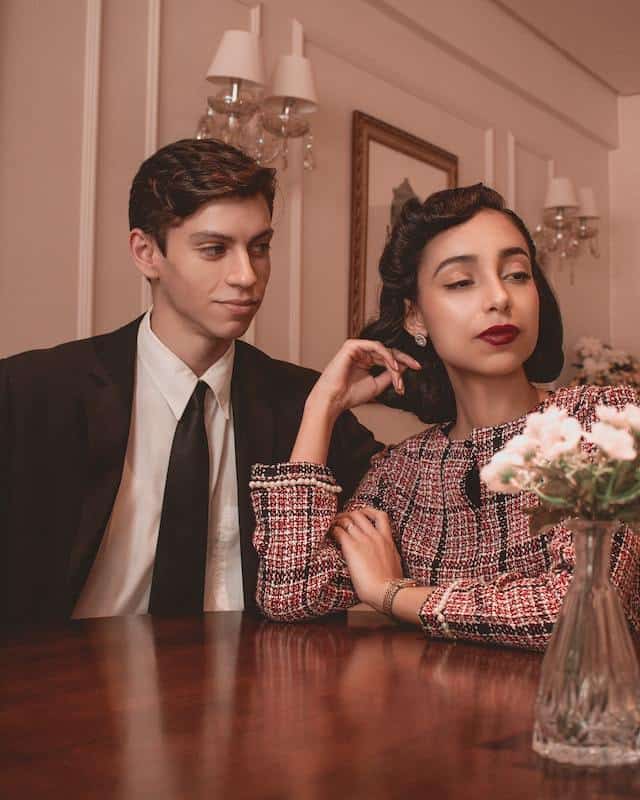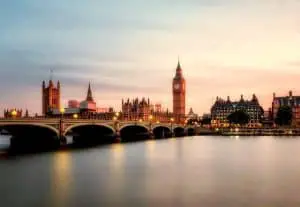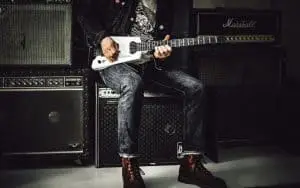The were a remarkable blend of practicality and glamour, driven by the unique circumstances of World War II.
From Christian Dior’s revolutionary “New Look” collection to the rise of American designers, this era saw fashion adapt and evolve like never before.
In this blog post, we will delve into the world of 1940s fashion trends for both men and women, exploring how wartime restrictions gave birth to new styles while celebrities embraced daring ensembles that would shape future decades.
We’ll also examine the accessories that defined this stylish decade – from hats to red nail polish – as well as discuss how post-war shifts in fashion brought about a return to femininity in women’s clothing and bolder looks for men.
Finally, we’ll celebrate some notable moments from this fascinating period in fashion history such as figure-cutting ensembles, patent leather making a comeback, and Christian Dior’s groundbreaking evening dress designs.
Let us explore the intricacies of 1940s fashion trends on our journey through time. The .
Table of Contents:
- Women’s Fashion in the Late 1940s: Elegance Amidst American Fashion
- Men’s Fashion Trends During World War II
- Accessories That Defined 1940s Style
- Post-War Shifts in Fashion Trends
- Notable Fashion Moments of the Late 1940s
- Conclusion
Women’s Fashion in the Late 1940s: Elegance Amidst American Fashion
Let’s take a trip down memory lane, shall we?
In spite of the difficulties presented by World War II, women in the 1940s embraced a sense of elegance and sophistication.
Ladies’ fashion at this time featured distinct styles, such as wide shoulders, narrow waistlines, and single-pleated A-line skirts.
Influencing post-war style like no other was Christian Dior’s “New Look” collection that took the fashion capital by storm.
A defining feature of women’s attire back then were boxy shoulders paired with slim-belted waistlines – talk about chic.
You’d be surprised to know that pantsuits and high-waisted dress pants became increasingly popular among women thanks to celebrities embracing them for their comfort and versatility.
Trousers for Women: Breaking Stereotypes
The rise of trousers in women’s fashion marked a significant shift from traditional norms.
This change can be attributed to practicality during the war years when women needed comfortable yet stylish clothing options while working or volunteering on various fronts.
Pantsuits: A Bold Fashion Statement
From Katherine Hepburn to Marlene Dietrich, Hollywood icons made pantsuits a fashion statement, inspiring women everywhere to embrace this trend.
High-Waisted Dress Pants: Comfort Meets Elegance
For a look that combined comfort and sophistication, women of the 1940s often opted for high-waisted dress pants instead of suits.
Their versatility allowed them to be dressed up or down depending on the occasion – truly a fashion staple.
So there you have it – an overview of the elegant women’s fashion of the late 1940s that flourished even during challenging times.
Eager to learn more about vintage fashion? Check out this educational resource by Vintage Fashion Guild.
Men’s Fashion Trends During World War II
Let’s journey to the 1940s, when men’s fashion was heavily shaped by military uniforms due to shortages of clothing materials.
With wartime restrictions on clothing materials, adapting became essential for stylish gentlemen of that era.
Rationing and limited resources led to innovative designs in civilian attire inspired by those worn by soldiers.
Accessories That Defined 1940s Style
Let’s dive into the fascinating world of 1940s accessories and explore how they shaped the iconic look of the era.
Aside from the garments themselves, accessories played a crucial role in defining the style of the late 1940s, a time when women’s fashion was heavily influenced by American designers and the aftermath of World War II.
Hats: A Must-Have for Men and Women
In an age when hats were considered essential attire, both men and women sported stylish headwear during this decade.
Ladies often opted for chic tilt or turban hats, while gentlemen donned fedoras or trilbies as part of their daily ensemble.
The best part? Hats weren’t subject to wartime restrictions, allowing individuals to express their personal flair through unique pieces.
Red Nail Polish: The Glamour Statement Piece
A swipe of red nail polish was all it took to elevate any outfit with a touch of glamour during the 1940s.
This bold hue became synonymous with Hollywood stars like Rita Hayworth and quickly made its way into everyday fashion statements across America.
Fashioning Silhouettes with Full Coverage Undergarments
To achieve that perfect hourglass silhouette so popular in the ’40s, women relied on full coverage undergarments.
Girdles and bullet bras were essential for creating a smooth, shapely figure beneath those tailored day dresses and evening dresses.
Check out this guide to 1940s lingerie for more insights into the era’s foundation garments.
The Power of Personal Expression Through Accessories
In an age of wartime restrictions and limited resources, accessories became a powerful tool for self-expression in fashion.
From statement-making hats to vibrant nail polish shades, these small touches allowed individuals to showcase their unique style while adhering to the decade’s clothing regulations.
Accessories like suit jackets, trench coats, and aviator glasses were also hugely popular during this time, thanks in part to fashion icons like Marlene Dietrich and Katherine Hepburn who graced the pages of Harper’s Bazaar and other fashion magazines.
And let’s not forget the iconic shirtwaist dress, often adorned with silk tassels and worn with black dresses and wedge silhouette shoes, which became a staple of everyday wear in the 1940s.
The 1940s accessories served to exemplify the decade’s style, a combination of practicality and trendiness that symbolized the strength and ingenuity of those who had survived World War II, establishing it as an influential fashion hub.
Accessories played a crucial role in defining the style of 1940s fashion. Hats were essential attire, both men and women sported stylish headwear during this decade. Accessories became a powerful tool for self-expression in fashion allowing individuals to showcase their unique style while adhering to the decade’s clothing regulations.
Post-War Shifts in Fashion Trends
Hey there, fashion enthusiasts.
Let’s explore how the fashion world changed after World War II and how Christian Dior influenced this shift.
We’ll be discussing some key shifts that occurred during this period, so buckle up.
The Influence of Christian Dior on Post-War Fashion
In 1947, Christian Dior introduced his “New Look”, which revolutionized women’s clothing with its cinched waists and voluminous skirts.
This iconic collection brought back femininity to women’s wardrobes after years of wartime restrictions.
Return of Femininity in Women’s Clothing
As a result of Dior’s influence, women embraced more feminine silhouettes like A-line dresses and full skirts paired with fitted tops or jackets.
The return to pre-war elegance was a breath of fresh air for many who had grown tired of utilitarian styles imposed by wartime rationing.
Men Embracing the “Bold Look”
Moving on to menswear – returning soldiers were ready for change too.
The “Bold Look” emerged as an exciting new trend featuring bolder colors, patterns, and a more relaxed fit in suits.
Men’s fashion had never been so daring.
Wartime Restrictions Lifted
With the end of World War II, clothing restrictions were lifted, and manufacturers could finally distribute their creations internationally.
This meant greater variety for consumers and an opportunity to explore new styles that defied previous limitations.
The Rise of Casualwear
Last but not least, let’s talk about casualwear.
The late 1940s saw a rise in popularity for laid-back attire like Hawaiian shirts and pullovers as people began embracing comfort alongside style.
Casual Fridays, anyone?
With the post-war era came a shift in fashion trends that continues to shape our sartorial choices today, and there’s more vintage style history yet to explore.
Stay tuned for more fascinating insights into the world of vintage style.
Post-World War II fashion trends saw a return to femininity in women’s clothing with Christian Dior’s “New Look” collection, while men embraced bolder colors and patterns in suits. The end of wartime restrictions led to greater variety for consumers and the rise of casualwear like Hawaiian shirts.
Notable Fashion Moments of the Late 1940s
First up, we have the figure-cutting ensembles that took everyone by storm in 1943.
An eighteen-year-old girl rocked her bright red and green plaid skirt with a matching stocking cap, setting an unforgettable trend for years to come.
Moving on, let’s talk about patent leather.
- The Comeback: After its decline during the war years, patent leather made a triumphant return in various forms towards the end of the decade.
In 1948, Christian Dior shook things up once again when he introduced his first short-and-long evening dress design, which set new standards for elegance and sophistication.
The Popularity of Figure-Cutting Ensembles
This style emphasized women’s curves while maintaining modesty – think cinched waists paired with A-line skirts or fitted blouses tucked into high-waisted pants. Women’s fashion in the late 1940s was all about accentuating the hourglass silhouette.
Patent Leather Making a Comeback
Pumps, handbags, belts – you name it. Patent leather was hugely popular in the late 1940s, adding a touch of glamour to everyday wear. American designers like Marlene Dietrich and Katherine Hepburn were often seen sporting patent leather shoes and accessories.
Christian Dior’s Groundbreaking Evening Dress Designs
Not to be forgotten, the individual who caused a stir in fashion after WWII should also be mentioned. Christian Dior’s innovative designs included luxurious fabrics, intricate detailing, and silhouettes that celebrated femininity in all its forms. His evening gowns were particularly iconic, featuring the narrow waist and wide shoulders that were popular in previous decades, but with a new twist – the wedge silhouette. Dior’s designs were featured in Harper’s Bazaar and worn by fashion icons like Marlene Dietrich. His use of silk tassels and aviator glasses in his designs made him a true fashion visionary.
Department stores like Macy’s and Bloomingdale’s were the go-to places for women’s fashion in the late 1940s. Shirtwaist dresses and suit jackets were popular for everyday wear, while black dresses and trench coats were perfect for more formal occasions.
With that in mind, let us take a look at some of the most iconic fashion trends from the late 1940s. Which trend is your favorite?
The late 1940s were a time of notable fashion moments, including the popularity of figure-cutting ensembles that emphasized women’s curves while maintaining modesty. Patent leather made a comeback in various forms towards the end of the decade, and Christian Dior revolutionized post-World War II fashion with his innovative designs featuring luxurious fabrics and intricate detailing.
Conclusion
The 1940s saw a move to more ladylike silhouettes after the introduction of Christian Dior’s “New Look” line, while men embraced relaxed looks due to rationing. Women’s clothing saw a shift towards more feminine styles after Christian Dior’s “New Look” collection, while men adapted to wartime restrictions on materials and embraced casualwear trends. Accessories like hats, red nail polish, and full coverage undergarments also defined the era.
Post-war fashion saw a return of femininity in women’s clothing and men embracing bolder looks. Notable moments included figure-cutting ensembles, patent leather making a comeback, and Christian Dior’s groundbreaking evening dress designs. The 1940s’ fashion is still a great source of inspiration for modern-day designers.
As an Editor experienced with SEO, it’s important to note that some potential SEO keywords for this post could include “1940s fashion,” “post-war fashion,” “Christian Dior,” and “feminine styles.”
For those passionate about fashion and lifestyle, learning about the history of fashion can be both informative and inspiring. The 1940s were a pivotal time for fashion, with trends that continue to influence designers today. Whether you’re interested in vintage fashion or simply curious about the evolution of style, exploring the fashion trends of the past can be a fascinating journey.







